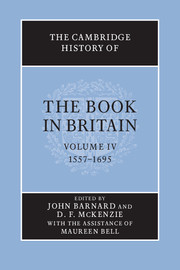Book contents
- Frontmatter
- Dedication
- Contents
- List of illustrations
- List of contributors
- Preface
- Acknowledgements
- Introduction
- RELIGION AND POLITICS
- ORAL TRADITIONS AND SCRIBAL CULTURE
- LITERATURE OF THE LEARNED
- LITERARY CANONS
- VERNACULAR TRADITIONS
- 21 The Bible trade
- 22 English law books and legal publishing
- 23 ABCs, almanacs, ballads, chapbooks, popular piety and textbooks
- 24 Books for daily life: household, husbandry, behaviour
- 25 The creation of the periodical press 1620–1695
- THE BUSINESS OF PRINT AND THE SPACE OF READING
- BEYOND LONDON: PRODUCTION, DISTRIBUTION, RECEPTION
- DISRUPTION AND RESTRUCTURING: THE LATE SEVENTEENTH-CENTURY BOOK TRADE
- STATISTICAL APPENDICES
- Abbreviations
- Bibliography
- Index
- Plate Section
- References
22 - English law books and legal publishing
from VERNACULAR TRADITIONS
- Frontmatter
- Dedication
- Contents
- List of illustrations
- List of contributors
- Preface
- Acknowledgements
- Introduction
- RELIGION AND POLITICS
- ORAL TRADITIONS AND SCRIBAL CULTURE
- LITERATURE OF THE LEARNED
- LITERARY CANONS
- VERNACULAR TRADITIONS
- 21 The Bible trade
- 22 English law books and legal publishing
- 23 ABCs, almanacs, ballads, chapbooks, popular piety and textbooks
- 24 Books for daily life: household, husbandry, behaviour
- 25 The creation of the periodical press 1620–1695
- THE BUSINESS OF PRINT AND THE SPACE OF READING
- BEYOND LONDON: PRODUCTION, DISTRIBUTION, RECEPTION
- DISRUPTION AND RESTRUCTURING: THE LATE SEVENTEENTH-CENTURY BOOK TRADE
- STATISTICAL APPENDICES
- Abbreviations
- Bibliography
- Index
- Plate Section
- References
Summary
William Fulbecke, in 1600, divided law books into four categories: historical (law reports and statutes), explanatory (glosses on texts, such as Staunford’s Prerogative), ‘miscellaneal’ (abridgments), and ‘monological’ (monographs on particular topics). Of the fourth category, which Fulbecke praised as the most orderly, few examples were then available. Besides Littleton and Perkins, on elementary land law, only two on criminal law deserved mention: Sir William Staunford’s Les plees del coron (1557) and William Lambard’s Eirenarcha (1581). Staunford was singled out by Fulbecke for its ‘force and weight, and no common kind of stile’, with the hope that ‘his method may be a law to the writers of the law which shall follow him’. But this was not yet the age of the advanced textbook. And older books, such as Bracton (first printed in 1569), though ‘not unprofitable to read’, were dangerous to trust. The third category was derived entirely from the first, and was designed to make the sources more accessible. Books in the second category were relatively uncommon in 1600. The prime example should have been readings in the inns of court, which were commentaries on statutes, and it is a telling reflection on the change in their status that they are not mentioned in the Direction at all.
Far more important than the other three as legal authorities were the books in Fulbecke’s first category, the undigested primary sources of the law: that is, the ever growing body of acts of Parliament and reports of cases. According to Fulbecke, ‘The common law is for the most part contained in all the books called the Annals of the Law or Year-books, all of which are to be read, if the student will attain to any depth in the Law.’
Keywords
- Type
- Chapter
- Information
- The Cambridge History of the Book in Britain , pp. 474 - 503Publisher: Cambridge University PressPrint publication year: 2002
References
- 3
- Cited by



